The Knights Templar
The Knights Templar were one of the most widely recognized religious military organizations of the Middle Ages. They enjoyed great military success, suffered stunning military defeats, and parlayed tax exemption into considerable wealth. In the early 14th Century, they met a sudden and violent end. Muslim armies had conquered the city of Jerusalem in the 7th Century. The city was sacred to Christians and Jews, as well as to Muslims, and many Christians made a habit of making a pilgrimage to Jerusalem to visit sites associated with Jesus, the founder of Christianity. 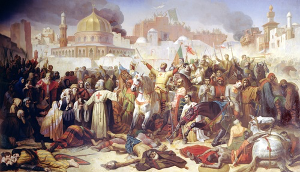
When Western forces took Jerusalem in 1099, during the First Crusade, they established the Kingdom of Jerusalem, one of four Crusader States. An order from Pope Paschal II in February of 1113 established the Knights Hospitaller, which had primarily a caregiving function at first and then later developed into a military protection organization as well. 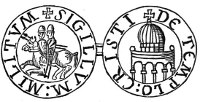
Travel to the Holy Land became increasingly treacherous, even with the protection of the Knights Hospitaller, and the Catholic Church in 1119 established another order to assist pilgrims, the Knights Templar. This order was set up with a military focus, and Templar knights provided protection for people making pilgrimages to Jerusalem and elsewhere in the Holy Land. Hugh de Payens, a French knight, organized the first patrol, which is believed to have been nine in number. The popularity of such pilgrimages increased, as did the need for protection for those undertaking such pilgrimages. Support from Christian monarchs encouraged the Knights Templar to join the Crusades and to station themselves at castles, passes, and other strategic points in the Middle East. 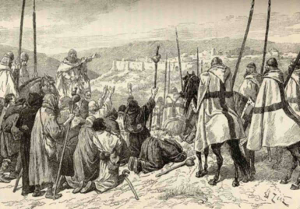
The name came about because the Knights lived in a wing of the royal palace, the former al-Aqsa Mosque in Jerusalem, in an agreement with the King of Jerusalem, Baldwin II. The mosque/palace was at a place known as the Temple Mount, supposedly the site of the Temple built by the ancient Israelite King Solomon. The official name of the order when it began was The Poor Knights of the Temple of King Solomon; later, the name was shortened to Knights Templar. 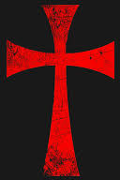
Discipline within the organization was strict. Members of the order swore oaths of poverty and abstinence from physical pleasures. They could not drink, gamble, or swear. They wore black or white robes with a red cross on the chest. (Knights wore white; non-knights wore a brown or black cloak.) Members could not wear the kind of fancy clothing to which other knights would have been accustomed; this extended to belts and gloves. Knights who might have been used to hawking or hunting could not engage in those pursuits. Meals were communal. Not surprisingly, attendance at regular church services was compulsory. In the early days of the order, some in Western Europe questioned the efficacy of religious men carrying swords. One strong proponent of the Indeed, members of the Knights Templar fought in the Crusades, at first in 1147 during the Second Crusade and then, 40 years later, alongside English King Richard I in his struggle against the Muslim warrior Saladin. One well-known victory of the Knights Temple was in the 1177 Battle of Montsigard, in which the much smaller group of Knights defeated a much larger force led by Saladin himself. 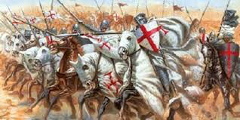
Knights were excellent with the crossbow, lance, and sword and sported efficient armor and shields. Disciplined and well-trained, the Knights, when fighting alongside other forces, would often protect an army's flanks from encroachment by the enemy. 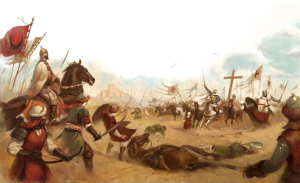
At the other end of the spectrum was the Knights cavalry charge. The well-honed attack could blast a hole through an enemy line, enabling trailing infantry to carve up an opponent. More than once, however, this strategy backfired as the trailing troops failed to keep pace and the hard-charging Knights were surrounded. Armed and armored knights are the most well-known symbol of the Knights Templar, but they were not the only members of the order. Another rank was sergeant, and these people filled various nonmilitary roles, including as baggage bearers, squires, craftsmen, and servants. Another rank was the chaplain, ordained priests who performed religious services for the other members. Some women were also members. In fact, some sources say that up to 90 percent of the members of the order did not take up arms. The Knights Templar gained superstar status in 1139, when papal bull from Pope Innocent II exempted the order from local laws, saying that they answered only to him. In practice, this meant that members of the order could ignore the authority of leaders of towns, cities, churches, and even countries. The papal bull also exempted the Knights Templar from paying taxes, even the normal tithe to the church. Not surprisingly, some in Western Europe viewed the order with suspicion. 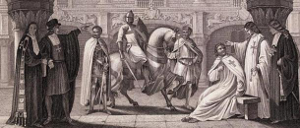
The organization developed a hierarchy, with a Grand Master, headquartered in Jerusalem, as head official. Members of the order gathered and live in convents, each of which had its own preceptor, who reported to the next level up in the chain of command, the priory. Convents had a large amount of autonomy. Other nonmilitary members included those who helped with financing, land administration, and other logistical matters. The Knights Templar grew very popular through the years, and many monarchs and other wealthy people gave donations to the organization. Some of these donations were money and weapons; other people gave tracts of land. The order used their wealth to buy churches, farms, mills, vineyards, and even entire towns. The order opened chapters in England, France, Portugal, Scotland, and Spain. The Pope had given the Knights Templar tax-exempt status, and so the organization grew into a wealthy one, even functioning at times as a private bank. A pilgrim who didn't want to carry money while on the journey to the Holy Land could give that money to the Knights Templar, in exchange for a letter credit or IOU, which could be handed in at Templar headquarters in Jerusalem. This practice grew more and more common, and the Templars began to use their money, in 1191 buying the island of Cyprus. 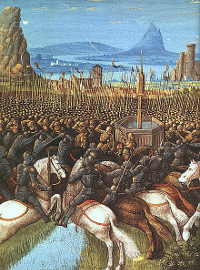
Crusaders called on the Knights Templar again and again, the Knights responded time and again. The Crusades ultimately ended in a failure to retake the Holy Land, and the resumption of Muslim rule in Acre in 1291 is said to have been the death knell of Crusader expeditions. Despite the presence of the vaunted Knights Templar, Western armies did not achieve their objectives. Western European nations began to turn inward, lessening their focus on the Middle East. Support for the Knights Templars waned as well. After Acre fell, the Templars relocated their headquarters to Cyprus and began talking about founding a monastic state, just as the Knights Hospitaller later did in Rhodes. Not all European leaders held the Knights Templar in high esteem. One who certainly did not was France's King Philip IV. As it turned out, Philip owed the order a lot of money because he had borrowed heavily from them in order to finance a war against England in the 1290s. He was also suspicious of the motives of the order, now that their original remit was less and less in demand. 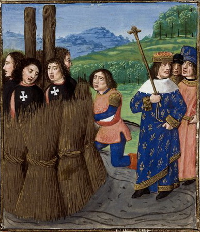
In 1307, Philip had members of the Knights Templar arrested, on Friday, the 13th of October. The Knights were tortured into giving false confessions of embracing sacrilege and of committing wicked and sinful acts. England's king, Edward II, followed suit, ordering the arrest of leaders of the order based there. The papacy, which had commissioned the Knights Templars in the first place, now turned on the order, ordering them arrested all over Europe. In 1310, Philip IV had 54 Templars burned at the stake. More executions followed, including the Grand Master, James of Molay, in 1314. In the meantime, Pope Clement V had ordered the Knights dissolved and their property seized. The Pope gave some Templar lands to the Knights Hospitaller. (Clement V had summoned the Grand Masters of both orders to a conference in 1305, seeking a way to combine the two; neither order was interested.) The situation in England was not as harsh as in France. Most English members of the order were not arrested; persecution of the leaders was relatively brief. When the order was dissolved, English society allowed Knights to find their way without harassment. Some joined the Knights Hospitaller. The rest did not. In Portugal, the Knights Templar carried on but under a different name, the Order of Christ. Long skilled in naval matters, the order lent its expertise to the Portuguese exploration effort. In fact, the famous Prince Henry the Navigator was the leader of Portugal's Order of Christ for two decades. |
|
Social Studies for Kids
copyright 2002–2026
David White



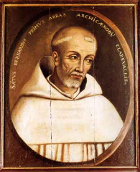 Knights Templar as a military organization was Bernard of Clairvaux, a nephew of one of the original nine Templars. A leading church figure at the time and the founder of the Cistercian Order, Bernard wrote a long treatise titled In Praise of the New Knighthood, in which he defended the carrying of weapons by the Knights Templars. One of the order, he said, "is truly a fearless knight, and secure on every side, for his soul is protected by the armour of faith, just as his body is protected by the armour of steel. He is thus doubly-armed, and need fear neither demons nor men."
Knights Templar as a military organization was Bernard of Clairvaux, a nephew of one of the original nine Templars. A leading church figure at the time and the founder of the Cistercian Order, Bernard wrote a long treatise titled In Praise of the New Knighthood, in which he defended the carrying of weapons by the Knights Templars. One of the order, he said, "is truly a fearless knight, and secure on every side, for his soul is protected by the armour of faith, just as his body is protected by the armour of steel. He is thus doubly-armed, and need fear neither demons nor men."
